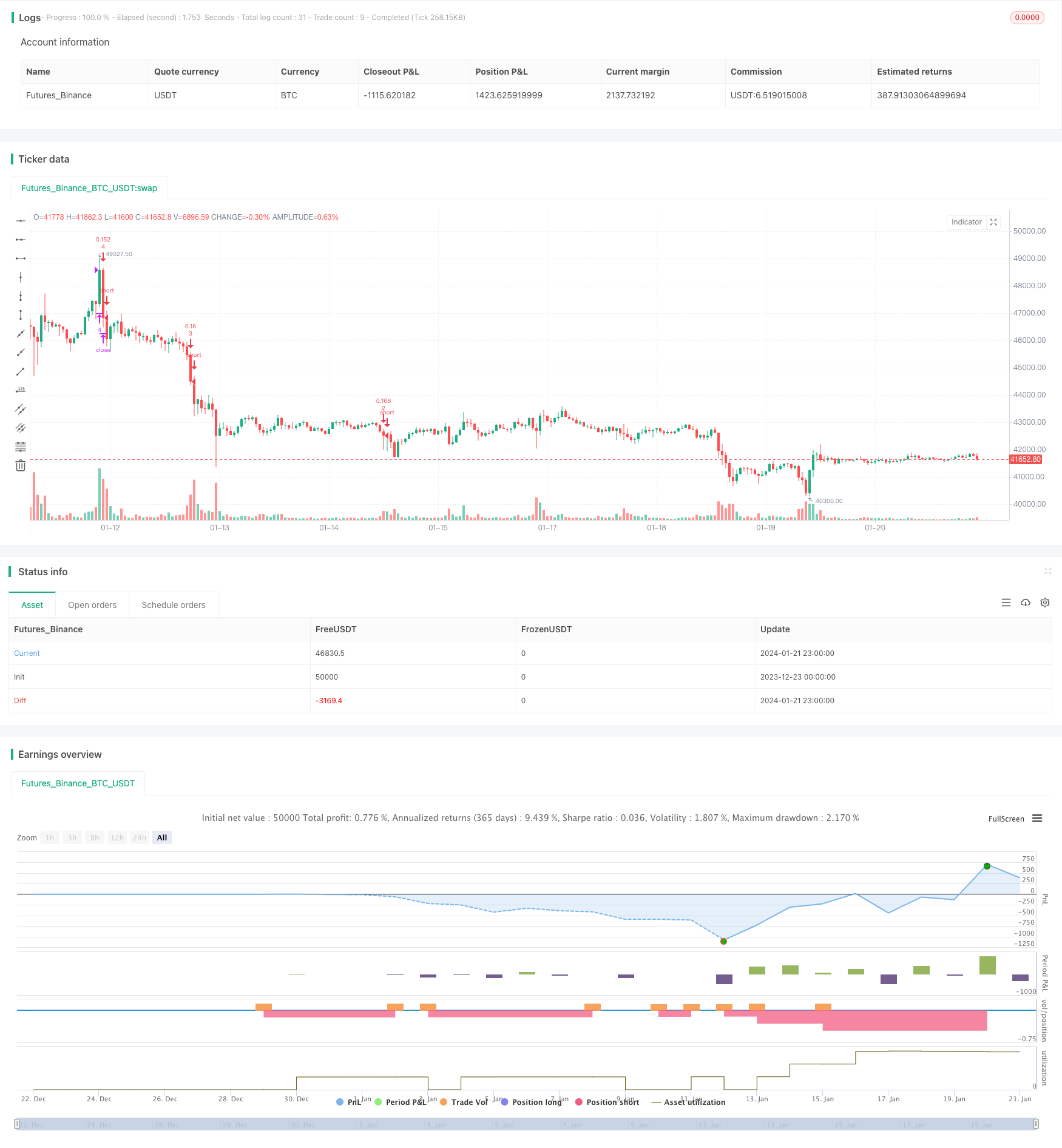
개요
이 전략은 가격 범위 내에서 여러 개의 병렬 구매/판매 주문을 설정하여 시장의 변동에 따라 격자 영역과 라인을 조정하여 수익을 창출하는 것을 구현합니다.
전략 원칙
- 그리드 상하계를 설정할 수 있고, 수동으로 설정할 수도 있고, 최근 기간의 가격 상승과 하락에 따라 자동으로 계산할 수도 있다.
- 설정된 격자 수에 따라 격자 간격의 폭을 계산한다.
- 그릴 라인 값의 배열을 생성한다.
- 가격이 어떤 격자선보다 낮으면 그 선 아래에서 다중을 열고, 가격이 어떤 격자선보다 높으면 그 선 위에 공평한 상표를 열는다.
- 동적으로 격자 상단 경계, 간격 너비 및 격자 라인 가격을 조정하여 시장 변화에 적응하십시오.
우위 분석
- 수평과 변동 시장에서 안정적인 수익을 창출할 수 있으며, 일방적인 상황에 영향을 받지 않습니다.
- 수동 설정을 지원하는 것은 자동으로 격자 구간을 계산하는 것을 지원하며, 적응력이 강하다.
- 그리드 수, 그리드 너비 및 주문량을 조정하여 수익을 최적화 할 수 있습니다.
- 내장된 포지션 제어, 위험을 제어한다.
- 동적으로 격자 범위를 조정하여 정책의 적응성을 강화합니다.
위험 분석
- 큰 트렌드가 나타나면 큰 손실이 발생할 수 있습니다.
- 그리드 수와 포지션 설정이 잘못되면 위험이 커질 수 있습니다.
- 자동으로 계산된 격자 간격은 극단적인 경우에도 작동하지 않을 수 있습니다.
위험 해결 방법:
- 그리드 매개 변수를 최적화하고, 총 포지션을 엄격하게 제어한다.
- 큰 사태가 일어나기 전에 전략을 종료하라.
- 트렌드 지표와 결합하여 상황을 판단하고, 필요한 경우 전략을 종료한다.
최적화 방향
- 시장의 특성과 자본의 규모에 따라 최적의 격자 수를 선택하십시오.
- 다양한 시간 주기 최적화 그리드 자동 계산 파라미터를 테스트한다.
- 더 안정적인 수익을 얻기 위해 위탁량 계산 방법을 최적화하십시오.
- 다른 지표와 함께 대폭적인 상황을 판단하고, 전략 폐쇄 조건을 설정한다.
요약하다
이 동적 격자 거래 전략은 격자 간 변수를 동적으로 조정하여 시장 변화에 적응하여横盘 및 변동판에서 수익을 창출합니다. 적절한 포지션 컨트롤을 설정하는 동시에 위험을 제어 할 수 있습니다. 격자 변수를 최적화하여 추세 판단 지표와 결합하여 전략의 안정성을 더욱 향상시킬 수 있습니다.
전략 소스 코드
/*backtest
start: 2023-12-23 00:00:00
end: 2024-01-22 00:00:00
period: 1h
basePeriod: 15m
exchanges: [{"eid":"Futures_Binance","currency":"BTC_USDT"}]
*/
//@version=4
strategy("sarasa srinivasa kumar", overlay=true, pyramiding=14, close_entries_rule="ANY", default_qty_type=strategy.cash, initial_capital=100.0, currency="USD", commission_type=strategy.commission.percent, commission_value=0.1)
i_autoBounds = input(group="Grid Bounds", title="Use Auto Bounds?", defval=true, type=input.bool) // calculate upper and lower bound of the grid automatically? This will theorhetically be less profitable, but will certainly require less attention
i_boundSrc = input(group="Grid Bounds", title="(Auto) Bound Source", defval="Hi & Low", options=["Hi & Low", "Average"]) // should bounds of the auto grid be calculated from recent High & Low, or from a Simple Moving Average
i_boundLookback = input(group="Grid Bounds", title="(Auto) Bound Lookback", defval=250, type=input.integer, maxval=500, minval=0) // when calculating auto grid bounds, how far back should we look for a High & Low, or what should the length be of our sma
i_boundDev = input(group="Grid Bounds", title="(Auto) Bound Deviation", defval=0.10, type=input.float, maxval=1, minval=-1) // if sourcing auto bounds from High & Low, this percentage will (positive) widen or (negative) narrow the bound limits. If sourcing from Average, this is the deviation (up and down) from the sma, and CANNOT be negative.
i_upperBound = input(group="Grid Bounds", title="(Auto) Upper Boundry", defval=0.285, type=input.float) // for manual grid bounds only. The upperbound price of your grid
i_lowerBound = input(group="Grid Bounds", title="(Auto) Lower Boundry", defval=0.225, type=input.float) // for manual grid bounds only. The lowerbound price of your grid.
i_gridQty = input(group="Grid Lines", title="Grid Line Quantity", defval=8, maxval=15, minval=3, type=input.integer) // how many grid lines are in your grid
f_getGridBounds(_bs, _bl, _bd, _up) =>
if _bs == "Hi & Low"
_up ? highest(close, _bl) * (1 + _bd) : lowest(close, _bl) * (1 - _bd)
else
avg = sma(close, _bl)
_up ? avg * (1 + _bd) : avg * (1 - _bd)
f_buildGrid(_lb, _gw, _gq) =>
gridArr = array.new_float(0)
for i=0 to _gq-1
array.push(gridArr, _lb+(_gw*i))
gridArr
f_getNearGridLines(_gridArr, _price) =>
arr = array.new_int(3)
for i = 0 to array.size(_gridArr)-1
if array.get(_gridArr, i) > _price
array.set(arr, 0, i == array.size(_gridArr)-1 ? i : i+1)
array.set(arr, 1, i == 0 ? i : i-1)
break
arr
var upperBound = i_autoBounds ? f_getGridBounds(i_boundSrc, i_boundLookback, i_boundDev, true) : i_upperBound // upperbound of our grid
var lowerBound = i_autoBounds ? f_getGridBounds(i_boundSrc, i_boundLookback, i_boundDev, false) : i_lowerBound // lowerbound of our grid
var gridWidth = (upperBound - lowerBound)/(i_gridQty-1) // space between lines in our grid
var gridLineArr = f_buildGrid(lowerBound, gridWidth, i_gridQty) // an array of prices that correspond to our grid lines
var orderArr = array.new_bool(i_gridQty, false) // a boolean array that indicates if there is an open order corresponding to each grid line
var closeLineArr = f_getNearGridLines(gridLineArr, close) // for plotting purposes - an array of 2 indices that correspond to grid lines near price
var nearTopGridLine = array.get(closeLineArr, 0) // for plotting purposes - the index (in our grid line array) of the closest grid line above current price
var nearBotGridLine = array.get(closeLineArr, 1) // for plotting purposes - the index (in our grid line array) of the closest grid line below current price
strategy.initial_capital = 50000
for i = 0 to (array.size(gridLineArr) - 1)
if close < array.get(gridLineArr, i) and not array.get(orderArr, i) and i < (array.size(gridLineArr) - 1)
buyId = i
array.set(orderArr, buyId, true)
strategy.entry(id=tostring(buyId), long=true, qty=(strategy.initial_capital/(i_gridQty-1))/close, comment="#"+tostring(buyId))
if close > array.get(gridLineArr, i) and i != 0
if array.get(orderArr, i-1)
sellId = i-1
array.set(orderArr, sellId, false)
strategy.close(id=tostring(sellId), comment="#"+tostring(sellId))
if i_autoBounds
upperBound := f_getGridBounds(i_boundSrc, i_boundLookback, i_boundDev, true)
lowerBound := f_getGridBounds(i_boundSrc, i_boundLookback, i_boundDev, false)
gridWidth := (upperBound - lowerBound)/(i_gridQty-1)
gridLineArr := f_buildGrid(lowerBound, gridWidth, i_gridQty)
closeLineArr := f_getNearGridLines(gridLineArr, close)
nearTopGridLine := array.get(closeLineArr, 0)
nearBotGridLine := array.get(closeLineArr, 1)